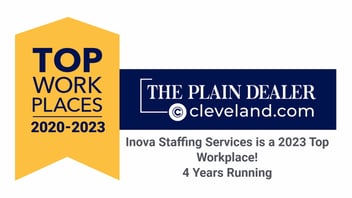How to Break Free From the “Busy” Trap
The following is a guest post from Candace Coleman (CultureWise). Candace is a writer and editor with a background in publishing and public relations.
How to Break Free From the “Busy” Trap

When you ask many working people how they are, their standard answer is, “Busy!” And a common reply is, “Well, busy is good!” But what does busyness really indicate, and does it add authentic value and meaning to our work lives? An overwhelming number of studies say a frantic activity pace is counterproductive. Far too often, busyness is actually bad for business.
Putting Busyness on a Pedestal
In contrast to bygone eras where having leisure time was seen as a sign of success, Americans have elevated “being busy” to a symbol of achievement. Sociologist Jonathan Gershuny says people now consider busyness a badge of honor and “the signifier of dominant social status.”
But simply being busy isn’t sufficient to achieve prestige. To get the status bump, others need to observe someone’s hyperactivity. The authors of a Columbia University study use the term “conspicuous consumption of time” to define overt busyness in the workplace. They conclude that:
“positive status inferences in response to long hours of work and lack of leisure time are mediated by the perceptions that busy individuals possess desired human capital characteristics (competence, ambition), leading them to be viewed as scarce and in demand.”
They documented data extrapolated from media platforms like Twitter, confirming that people’s “humble brags” frequently cited long work hours that consumed their lives.
In an article for LinkedIn, Julia Dhar explains that busyness is a self-fulfilling phenomenon. She says people across the business spectrum “have both advertently and inadvertently created and amplified the ‘busy game.’”
Dhar conducted a survey that showed that 95 percent of professionals considered themselves somewhat or very busy. She concludes that as people view others’ activity levels, they increasingly feel the need to step theirs up. FOMO kicks in, and they literally compete to appear busier.
The Downside of Being Too Busy
Sociologists and business analysts are growing more vocal about the negative effects of putting a premium on workplace busyness. As Dhar notes, the push to be always on “runs counter to building workplace cultures that honor the whole person.” This treadmill, she writes, is “potentially unproductive, exhausting, and detrimental to company culture and our personal well-being.”
The busyness trap undermines leadership. And one of the biggest reasons leaders get buried in work is their unwillingness to delegate. They justify this behavior by saying it takes longer to tell people how to do something than to do it themselves. Or they simply think they’ll do it better. Or they believe delegating makes them look weak, and they want to be respected.
But failure to delegate robs them of time they could spend on more strategic efforts and prevents their team members from learning and growing. And as organizational psychologist Nicole Lipkin points out in a Forbes article, “Ironically, people end up respecting their leader less when they don’t delegate.” employees resent do-it-all leaders who appear not to trust them with responsibilities.
In her blog, organizational consultant Maureen Douglas outlines additional pitfalls of leaders who spread themselves too thin. Too often, busy leaders:
- Don’t communicate consistently
- Aren’t strategic
- Are poor critical thinkers
- Don’t listen effectively
- Resent staff needing their time
- Are easily distracted
In general, overly busy leaders are frequently poor role models who are too stressed to meet the needs of their staff and business.
And as detrimental as busyness is to high-level executives, it can take an even bigger toll on the rank and file.
Adam Waytz explains further in a recent article for Harvard Business Review:
“Research shows that since the 1990s, employees increasingly have been working harder and under tighter deadlines and more stressful conditions as they try to master additional skills to outpace the robots gunning for their jobs and as digital devices trap them in a 24/7 workplace. This has taken a significant toll on mental and physical health.”
Waytz notes that efficiency and productivity drop when employees are overloaded. And he adds that exhausted workers are more prone to quitting, which not only takes a personal toll, but companies incur the high cost of hiring and training replacements. And a “busy is good” culture for those who elect to stay can leach employee engagement and increase absenteeism.
Quality Achievement Vs. Frenetic Activity
Leaders need high-performing teams to be competitive. But busyness doesn’t necessarily equate to profit. Instead of basing incentives mainly on the amount of time put in, they should prioritize results and quality of work.
Adam Waytz offers company executives five recommendations to create a culture that maximizes their employees’ potential while preserving their well-being.
- Reward output, not just activity.
Paying people for more effort doesn’t result in more productivity. Waytz cites a University of Texas study that shows that people work longer but with less effort if they are paid for hours spent on a task rather than the result. But he cautions that rewarding output alone can stifle creativity, which takes time and the leeway for trial and error. He recommends balanced compensation programs that offer incentives based on input and output to maximize innovation and productivity. He also stresses the importance of rewarding people for the quality of their work. - Generate deep work and eliminate low-value work.
The double-edged sword of technology speeds us up and slows us down. The multiple platforms we use to communicate and organize our work also hold us hostage as we endure constant interruptions. The price we pay is a reduced attention span and less ability to perform meaningful deep work that requires sustained focus.
But in an attempt to boost efficiency, many organizations push people to multitask via technology. Ironically, American Psychological Association research shows that trying to do many things at once reduces productivity by as much as 40 percent. Waytz recommends, “Organizations should perform audits of whether work does in fact engage employees rather than simply keep them on the clock. Once the shallow tasks have been identified, managers can determine whether to eliminate them or replace them with something more efficient.” - Force people off the clock.
The U.S. Travel Association reports that more than half of Americans don’t use all their paid vacation days. They found that worries about work were the main reason holding people back, and many find it hard to disconnect from their jobs even when they take time off. In addition, the remote work trend makes it harder for people to “leave their jobs” when the workday ends. They remain tethered to work-related emails and texts that prevent them from reaping the benefits of downtime. - Model the right behavior.
Employees won’t feel comfortable taking time off or maintaining work/life unless they observe company leadership modeling this behavior. Leaders who set the example of building downtime into their schedules empower their staff to take healthy breaks. As Waytz observes:
“When managers demonstrate that their own busyness is not a prerequisite for success—being careful of course not to just dump their workloads on subordinates when they clock out—employees are more likely to believe it.”
Leaders can demonstrate that their downtime allows them to bring their best selves to work, making them more effective and energized. Leading by example helps their staff accept that disconnecting from work is not only acceptable but critical for success. - Build slack into the system.
Besides the psychological factors that ramp up busyness, workers feel compelled to maintain a stress-inducing activity level when their companies have to cut staff and resources. These cost-saving measures may be short-term solutions, but they can cause organizations to deteriorate in the long run.
Waytz recommends building slack or rebar into the business to prevent the downfall that too much overwork can cause. He acknowledges that this recommendation may be the hardest for organizations to accept as they’re keeping an eye on the bottom line. But as noted business author and strategist Seth Godin points out, “Systems with slack are more resilient. The mistake happens when we over-index on easily measured short-term wins and forget to account for the costs of system failure.”
Waytz describes various types of slack that can alleviate employee hyper-busyness and resulting negative consequences. They include enhanced resources, reallocating existing resources, allowing for SOP deviation when necessary, and human redundancy—not counting on one person to do specific work.
He notes that these tactics can cost more money. Still, he adds: “Losing good employees or loyal customers because of a burdensome, overly busy work environment or slow service will ultimately cost more money.”
Waytz calls the busyness trend in the work arena an epidemic taking a significant toll on mental and physical health. And all the evidence shows that while hyperactivity makes it look like things are happening at a more rapid pace, it actually prevents organizations from thriving. Leaders who instill a culture of conscientious time use, reward output and quality instead of just effort, and validate employee well-being will build more sustainable and profitable organizations.
Inova Staffing Insights
 Dan Barnett, President & CEO of Inova Staffing, says:
Dan Barnett, President & CEO of Inova Staffing, says:
As advocates for effective leadership and employee well-being, our team at Inova Staffing understands the importance of rewarding quality output, encouraging deep work, and modeling balanced behavior at all levels. Our approach to staffing and talent acquisition mirrors the need for companies to build resilience by valuing both productivity and the well-being of their teams. Inova Staffing is dedicated to helping organizations find the right talent and create environments where success is defined by meaningful accomplishments, not just relentless activity.
Interested in More Employment Resources?
Whether looking for a job or seeking new candidates, the Better Together Blog is packed with advice and insights to help you succeed. Subscribe below to receive the latest content in your inbox—directly from staffing industry experts.

Enter your email address to receive updates when we publish new content.



